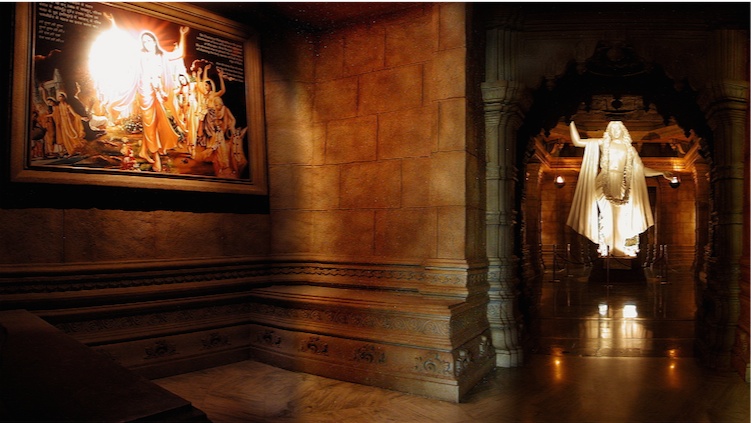ISKCON Delhi’s Vedic Museum To Add Two New Exhibits
By Madhava Smullen | Feb 06, 2015

The Vedic Museum – popularly known as the “Vedic Expo” – at ISKCON New Delhi’s massive Glory of India Vedic Cultural Center is in the process of adding two new exhibits. These will be incorporated into its section on the Chaitanya Charitamrita, the sixteenth century biography of Gaudiya Vaishnava Saint Chaitanya Mahaprabhu.
The first will depict Namacharya Srila Haridas Thakur, known for his dedication to chanting God’s Holy Names, sitting and performing japa meditation in Puri, Orissa with the famous Jagannath Temple in the background.
The second will feature the five most recent in the Gaudiya Vaishnava line of gurus – Jagannath Das Babaji, Srila Bhaktivinode Thakur, Gaura Kishora Das Babaji, Bhaktisiddhanta Saraswati Thakur, and ISKCON founder Srila Prabhupada. Each will be set in a different background – one sitting under a tree, another on some grass, and another on a raised asana.

The Vedic Expo takes up a huge portion of the ISKCON Delhi complex
“The idea is to let people know about these great acharayas and how ISKCON has come from a bona fide disciplic succession,” says technical director Niranjana Das.
The new additions will add to the appeal of the already extremely popular museum, which has drawn over three million people since it was inaugurated in April 1998 by then Indian Prime Minister Sri Atal Bihari Vajpayee.
The driving force behind this impressive project is Delhi GBC Gopal Krishna Goswami. Designed by an international bevy of talented artists including Italian musician Krishna Prema Das, photographer Nitya Tripta Dasi and American sculptor Bhaktisiddhanta Das, the museum combines Western technology and Vedic philosophy to utilize the best of both worlds. It includes several different sections, each with their own absorbing journeys into the stories and philosophy of the ancient Vedic literature.

A group of western tourists pose outside the Bhagavad-gita Experience
The Vedic Safari takes visitors through the timeless epics the Mahabharata, Ramayana, Srimad Bhagavatam, and Chaitanya Charitamrita, bringing them to life with 3D displays, narrations, lighting effects, and art galleries. The Chaitanya Charitamrita section also features a replica of a fifteenth-century temple. And the Srimad-Bhagavatam section features India’s only quadroscope, a giant globe that uses a multi-video wall and a large mirror to create the effect of hundreds of screens.
The eight-room Bhagavad-gita Experience, for which Delhi 3D computer modeler Vivek Guha and UK crowd-flow consultant Brian Bath were brought in, is a half-hour dramatic tour depicting the concepts of reincarnation, divine nature, eternal time, physics, yoga and the universe through dioramas and sound and light shows.
Perhaps the piece de resistance is an animatronics stage show on the Bhagavad-gita in a 150-person-capacity hall, performed by nine robots created in Los Angeles by the same company that created the dinosaurs in the film Jurassic Park.

A sage in the Bhagavad-gita exhibit
“There are three primary robots of Krishna, Arjuna and Srila Prabhupada in the center of the stage, which are life-sized and move even their lips, hands and eyes,” says Niranjana. “Then on each side there are partially moving robots of Srila Prabhupada – one standing on the Jaladuta steamship he took to the USA with the Boston skyline in the background, and the other sitting and writing at the Radha Damodar temple in Vrindavana. Digital surround sound, lighting effects, fog machines and a triple-screen video complete the experience.”
Today, 2,000 to 2,500 people, mostly tourists from all over India, visit the Expo daily during the peak months of May and June. From November to January every year, thousands of school students stream through its exhibits. And from September to March, many tourists from Europe and the U.S. visit, including most recently U.S. Democratic Congresswoman Tulsi Gabbard.

The Srimad-Bhagavatam gallery
“The museum has a very positive effect on people, and leaves a lasting impression,” says Niranjana. “Young people who are usually more interested in their smartphones and iPads than in Vedic knowledge are very impressed when they see it depicted using modern technology. Many visitors return with their friends and relatives to show them the exhibits. Some are inspired to donate towards ISKCON Delhi’s other spiritual activities. And some query further, and are connected with communities like our ISKCON Youth Forum and congregational groups.”
In the future, as well as adding the two new Chaitanya Charitamrita exhibits, the museum’s directors are looking to update their shows to incorporate the latest technologies like 3D holographic displays and 8D motion simulators.

A scene from the Srimad-Bhagavatam using lighting effects
“Our purpose is to help our visitors appreciate the ancient culture of India and understand the important teachings of the timeless Vedas,” Niranjana says. “We want to whet the appetite of scholars and laypersons alike for the primary and supplementary Vedic literature, and to elevate these literatures to the position they deserve. We are positive that the Expo will impress and inspire people to follow spiritual principles and thereby experience peace, harmony, and ultimate perfection in their lives.”

The Quadrascope















